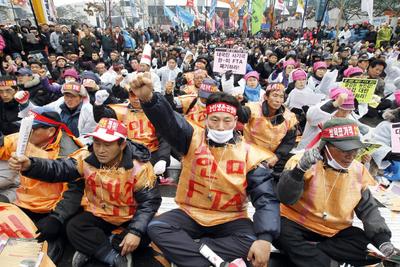Korea is no exception – the prohibitive effects on EU exports are equivalent to the effects of a tariff of 76 per cent; compared to Korea’s tariff protection at merely 12 per cent on an average. Rightly pursued, bilateral trade agreements can reduce these NTBs, often in a non-discriminatory fashion, bringing the benefits to a larger set of countries.
It was not a coincidence that the bilateral agendas of both the EU and US pointed to Seoul. Ostensibly, Korea is one of the world’s most trade dependent economies with a trade-to-GDP ratio of 96 per cent (as per the OECD). Further, Korea offered substantial domestic reforms in exchange for market access and its small size made it less likely to cause any job displacement and protests at home – or so it was thought. Commencing in May 2007 in Seoul, the negotiations with the EU took place against the backdrop of the 2008 crisis, which made trade liberalisation highly unpopular.
The importance of autos
Korea manufactures about 3.5 million cars annually, and exports nearly three quarters (73 per cent) of those manufactured. As a result, no other issue was so politically sensitive as potential effects on both the European and US automotive industry from Korean imports – despite the fact that imports from Korea were disproportionately hit and halved during the crisis.
Similarly, the Korean automotive market was also virtually closed off after many decades of mercantilist policies and import substitution regimes. Imports accounted for only 6 per cent of the market. Italy – which threatened to veto the EU-Korea agreement – has not exported a single car to Korea during the past five years. Therefore, during negotiations, both the EU and the US used all their leverage to secure market access for their auto manufacturers. As a result, Korean protection standards on car safety and components were scaled down to international standards in the EU-Korea FTA – standards that the EU conveniently already complies with. As a result, EU exports are also expected to grow by over 400 per cent, albeit from very low levels. Similarly, the demands pushed by the US in the recent renegotiation were more or less all in the automotive sector, and Korea finally gave into to soften the safety and emission requirements for US made cars.
Given the resistance to vehicle importation in the EU and the US, Korea’s concessions were reciprocated with caution. Tariff barriers in the EU and US will be slowly phased out over five years (and eight years for trucks in the US) while both will maintain safeguard measures, allowing them to null the agreement in the case of sudden import surges.
The new FTA mercantilism
The attitudes of the EU and the US in their negotiations highlighted a new ‘FTA mercantilism’ where trade negotiations are fallaciously perceived as zero-sum games, focused entirely on moving the trade balance to one’s favour. More importantly, the gains of imports were neglected, despite the welfare increase and the dynamic effects from better use of internal resources surpass gains of improved market access, when regulatory reforms and imports force firms to behave more productively in a time when particularly competitiveness is slacking off. The mercantilist approach of large countries and economies in swapping ‘exports-against-export’ has impeded the recognition of the full potential of FTAs.
While the EU and US FTAs are now waiting to be ratified by respective legislative body, their outlooks are now less than certain. While the automotive sector accounts for less than 1 per cent of US GDP, it is constantly punching above its weight – especially as a less ambitious agreement makes other sectors feel that they have little to gain, or lose. Meanwhile, a rejection of the EU-Korea FTA in the European Parliament will be definite.
Europe simply does not have elections with such agenda-shifting outcomes, and a failure to ratify the FTA is a rejection of the ‘model-FTA’ that would have served as the opening bid for tougher negotiations with larger trading partners in the region. If the agreements with Korea are rejected, then it is difficult to envisage whether the or the EU would attempt an FTA with Japan (a bigger car exporter and even more sensitivity about imports and services liberalisation) or even what such an FTA would look like.
Hosuk Lee-Makiyama is co-Director of the European Centre for International Political Economy (ECIPE), Brussels.

